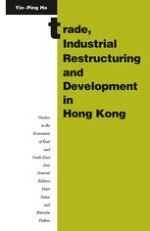1992 | OriginalPaper | Buchkapitel
Growth Experience and Structural Changes
verfasst von : Yin-Ping Ho
Erschienen in: Trade, Industrial Restructuring and Development in Hong Kong
Verlag: Palgrave Macmillan UK
Enthalten in: Professional Book Archive
Aktivieren Sie unsere intelligente Suche, um passende Fachinhalte oder Patente zu finden.
Wählen Sie Textabschnitte aus um mit Künstlicher Intelligenz passenden Patente zu finden. powered by
Markieren Sie Textabschnitte, um KI-gestützt weitere passende Inhalte zu finden. powered by
Hong Kong’s basic economic structure is that of a city economy. It is small, densely populated, and heavily dependent upon outside resources for most of its food and raw material supplies. Hong Kong’s total land area now totals 1071 square kilometres (about 413 square miles). Of this, about 16.8 per cent is built up, and less than 9 per cent is suitable for crop and fish farming, while scrub and grasslands, badlands and afforested areas claim the remaining 75 per cent. Most of the 5.7 million population cram into an area of about 105 square kilometres of the built-up land. Beyond doubt, land is a highly scarce resource in Hong Kong, which is not only limited in size but topographically much constrained for urban development. In the post-war period, a large proportion of new land required for urban expansion has had to be created at considerable cost by the government through reclamation from the sea and the levelling of hills.
